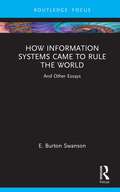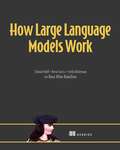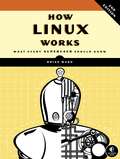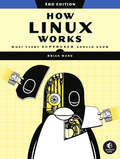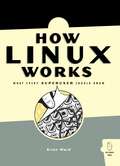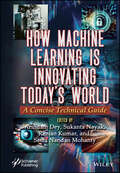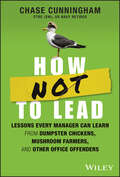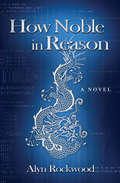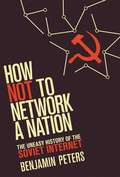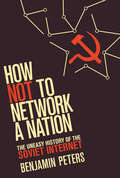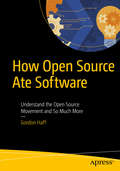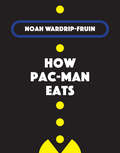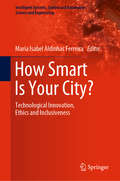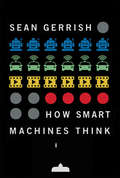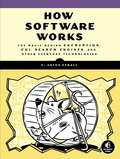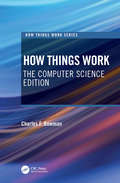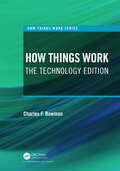- Table View
- List View
How Images Think
by Ron BurnettDigital images are an integral part of all media, including television, film, photography, animation, video games, data visualization, and the Internet. In the digital world, spectators become navigators wending their way through a variety of interactive experiences, and images become spaces of visualization with more and more intelligence programmed into the very fabric of communication processes. In How Images Think, Ron Burnett explores this new ecology, which has transformed the relationships humans have with the image-based technologies they have created. So much intelligence has been programmed into these image-dependent technologies that it often seems as if images are "thinking"; ascribing thought to machines redefines our relationship with them and enlarges our ideas about body and mind. Burnett argues that the development of this new, closely interdependent relationship marks a turning point in our understanding of the connections between humans and machines. After presenting an overview of visual perception, Burnett examines the interactive modes of new technologies -- including computer games, virtual reality, digital photography, and film -- and locates digital images in a historical context. He argues that virtual images occupy a "middle space," combining the virtual and the real into an environment of visualization that blurs the distinctions between subject and object -- part of a continuum of experiences generated by creative choices by viewers, the results of which cannot be attributed either to images or to participants.
How Information Systems Came to Rule the World: And Other Essays (Routledge Focus on IT & Society)
by Burt SwansonThis book offers a fresh perspective on information systems, a field of study and practice currently undergoing substantial upheaval, even as it expands rapidly and widely with new technologies and applications. Mapping the field as it has developed, the author firmly establishes the under-recognized importance of the field, and grounds it firmly in the subject’s history. He argues against the view of enthusiasts who believe that the field has somehow moved "beyond information systems" to something more exotic and offers a short and compelling manifesto on behalf of the field and its future. Offering a comprehensive insight into the significance of the information systems field, this book will appeal primarily to scholars and practitioners working in information systems, management, communication studies, technology studies, and related areas.
How Intranets Work
by Preston GrallaNow you can learn how intranets work, what they can and cannot do for your organization. This is a great beginner's guide to intranets.
How JavaScript Works: Master the Basics of JavaScript and Modern Web App Development
by Jonathon SimpsonJavaScript is a complicated language with a lot of misinformation surrounding how it works. This book provides a comprehensive introduction to JavaScript, from how it works at a technical level to how it is used to create websites and applications. Everything you need to know to start a career in JavaScript development is covered here. How JavaScript Works begins with a practical introduction of the basics before moving into the technical underpinnings of JavaScript, detailing everything you need to know, including variables, memory storage, functions, classes, types, maps, sets and APIs. Once you’ve fully absorbed these key topics. author Jonathan Simpson will show you how to put them into practice, demonstrating how they are employed for modern web development. You’ll learn how to use JavaScript with HTML and CSS to construct web pages and applications, how to change CSS with JavaScript, and how to utilize Fetch and asynchronous operations. Upon completing this book, you will have the foundational knowledge necessary to continue your journey to becoming a professional JavaScript developer. What You Will Learn: Gain insight into the technical essentials of JavaScript and how it worksLearn advanced concepts and such as memory storage and how classes, functions and objects actually workExplore the basic mathematical underpinnings of JavaScriptUnderstand how JavaScript is used to manipulate HTML and CSSObtain the tools and knowledge needed to start your career in web development Who This Book Is For: Anyone interested in a web development career, as well as those who may have already embarked on their careers, but who want to deepen their technical understanding of JavaScript and how it works.
How Large Language Models Work
by Drew Farris Edward Raff Stella BidermanLearn how large language models like GPT and Gemini work under the hood in plain English.How Large Language Models Work translates years of expert research on Large Language Models into a readable, focused introduction to working with these amazing systems. It explains clearly how LLMs function, introduces the optimization techniques to fine-tune them, and shows how to create pipelines and processes to ensure your AI applications are efficient and error-free. In How Large Language Models Work you will learn how to: • Test and evaluate LLMs • Use human feedback, supervised fine-tuning, and Retrieval Augmented Generation (RAG) • Reducing the risk of bad outputs, high-stakes errors, and automation bias • Human-computer interaction systems • Combine LLMs with traditional ML How Large Language Models Work is authored by top machine learning researchers at Booz Allen Hamilton, including researcher Stella Biderman, Director of AI/ML Research Drew Farris, and Director of Emerging AI Edward Raff. They lay out how LLM and GPT technology works in plain language that&’s accessible and engaging for all. About the Technology Large Language Models put the &“I&” in &“AI.&” By connecting words, concepts, and patterns from billions of documents, LLMs are able to generate the human-like responses we&’ve come to expect from tools like ChatGPT, Claude, and Deep-Seek. In this informative and entertaining book, the world&’s best machine learning researchers from Booz Allen Hamilton explore foundational concepts of LLMs, their opportunities and limitations, and the best practices for incorporating AI into your organizations and applications. About the Book How Large Language Models Work takes you inside an LLM, showing step-by-step how a natural language prompt becomes a clear, readable text completion. Written in plain language, you&’ll learn how LLMs are created, why they make errors, and how you can design reliable AI solutions. Along the way, you&’ll learn how LLMs &“think,&” how to design LLM-powered applications like agents and Q&A systems, and how to navigate the ethical, legal, and security issues. What&’s Inside • Customize LLMs for specific applications • Reduce the risk of bad outputs and bias • Dispel myths about LLMs • Go beyond language processing About the Readers No knowledge of ML or AI systems is required. About the Author Edward Raff, Drew Farris and Stella Biderman are the Director of Emerging AI, Director of AI/ML Research, and machine learning researcher at Booz Allen Hamilton. Table of Contents 1 Big picture: What are LLMs? 2 Tokenizers: How large language models see the world 3 Transformers: How inputs become outputs 4 How LLMs learn 5 How do we constrain the behavior of LLMs? 6 Beyond natural language processing 7 Misconceptions, limits, and eminent abilities of LLMs 8 Designing solutions with large language models 9 Ethics of building and using LLMs
How Linux Works, 2nd Edition: What Every Superuser Should Know
by Brian WardUnlike some operating systems, Linux doesn’t try to hide the important bits from you—it gives you full control of your computer. But to truly master Linux, you need to understand its internals, like how the system boots, how networking works, and what the kernel actually does.In this completely revised second edition of the perennial best seller How Linux Works, author Brian Ward makes the concepts behind Linux internals accessible to anyone curious about the inner workings of the operating system. Inside, you’ll find the kind of knowledge that normally comes from years of experience doing things the hard way. You’ll learn:–How Linux boots, from boot loaders to init implementations (systemd, Upstart, and System V)–How the kernel manages devices, device drivers, and processes–How networking, interfaces, firewalls, and servers work–How development tools work and relate to shared libraries–How to write effective shell scriptsYou’ll also explore the kernel and examine key system tasks inside user space, including system calls, input and output, and filesystems. With its combination of background, theory, real-world examples, and patient explanations, How Linux Works will teach you what you need to know to solve pesky problems and take control of your operating system.
How Linux Works, 3rd Edition: What Every Superuser Should Know
by Brian WardBest-selling guide to the inner workings of the Linux operating system with over 50,000 copies sold since its original release in 2014. Unlike some operating systems, Linux doesn&’t try to hide the important bits from you—it gives you full control of your computer. But to truly master Linux, you need to understand its internals, like how the system boots, how networking works, and what the kernel actually does. In this third edition of the bestselling How Linux Works, author Brian Ward peels back the layers of this well-loved operating system to make Linux internals accessible. This edition has been thoroughly updated and expanded with added coverage of Logical Volume Manager (LVM), virtualization, and containers. You'll learn: • How Linux boots, from boot loaders to init (systemd) • How the kernel manages devices, device drivers, and processes • How networking, interfaces, firewalls, and servers work • How development tools work and relate to shared libraries • How to write effective shell scripts You&’ll also explore the kernel and examine key system tasks inside user space, including system calls, input and output, and filesystems. With its combination of background, theory, real-world examples, and patient explanations, How Linux Works, 3rd edition will teach you what you need to know to solve pesky problems and take control of your operating system.
How Linux Works: What Every Superuser Should Know
by Brian WardWhether you're a systems administrator or a home user, you need to understand how Linux internals work before you can really master Linux — how it boots, how networking works, how to customize the kernel, and even what hardware to buy.How Linux Works contains the kind of information normally handed down from wizards—knowledge that comes from years of experience doing things the hard way. But instead of seeking the right incantation to make your system work, you can read How Linux Works to see how to administer Linux and why each particular technique works.This book covers such need-to-know topics as:–How Linux boots, with coverage of boot loaders and init–How networking, interfaces, firewalls, and servers work–How development tools and shared libraries work–How the kernel manages devices, device drivers, and processes, and how to build a custom kernel–How the Linux printing system works, with sections on cups, filters, and Ghostscript–How shell scripts workWith its combination of background theory and real-world examples, How Linux Works will show you how to run your system instead of having your system run you.
How Machine Learning is Innovating Today's World: A Concise Technical Guide
by Arindam Dey Sukanta Nayak Sachi Nandan Mohanty Ranjan KumarProvides a comprehensive understanding of the latest advancements and practical applications of machine learning techniques. Machine learning (ML), a branch of artificial intelligence, has gained tremendous momentum in recent years, revolutionizing the way we analyze data, make predictions, and solve complex problems. As researchers and practitioners in the field, the editors of this book recognize the importance of disseminating knowledge and fostering collaboration to further advance this dynamic discipline. How Machine Learning is Innovating Today's World is a timely book and presents a diverse collection of 25 chapters that delve into the remarkable ways that ML is transforming various fields and industries. It provides a comprehensive understanding of the practical applications of ML techniques. The wide range of topics include: An analysis of various tokenization techniques and the sequence-to-sequence model in natural language processing explores the evaluation of English language readability using ML models a detailed study of text analysis for information retrieval through natural language processing the application of reinforcement learning approaches to supply chain management the performance analysis of converting algorithms to source code using natural language processing in Java presents an alternate approach to solving differential equations utilizing artificial neural networks with optimization techniques a comparative study of different techniques of text-to-SQL query conversion the classification of livestock diseases using ML algorithms ML in image enhancement techniques the efficient leader selection for inter-cluster flying ad-hoc networks a comprehensive survey of applications powered by GPT-3 and DALL-E recommender systems' domain of application reviews mood detection, emoji generation, and classification using tokenization and CNN variations of the exam scheduling problem using graph coloring the intersection of software engineering and machine learning applications explores ML strategies for indeterminate information systems in complex bipolar neutrosophic environments ML applications in healthcare, in battery management systems, and the rise of AI-generated news videos how to enhance resource management in precision farming through AI-based irrigation optimization. Audience The book will be extremely useful to professionals, post-graduate research scholars, policymakers, corporate managers, and anyone with technical interests looking to understand how machine learning and artificial intelligence can benefit their work.
How NOT to Lead: Lessons Every Manager Can Learn from Dumpster Chickens, Mushroom Farmers, and Other Office Offenders
by Chase CunninghamStep Aside, Mediocre Leaders: Learn What NOT To Do! Ditch the fluff and sugarcoating and learn how to lead the way your people deserve. In How NOT To Lead, Dr. Chase Cunningham, a seasoned cybersecurity heavyweight and Retired Navy Chief, doesn't give you a textbook guide on leadership — he delivers a no-holds-barred, gloves-off masterclass on the lethal mistakes that'll tank your leadership game and ultimately sink your reputation and even your company's future. Want the brutal truth? This book slaps you with some cold, hard realities: What happens when you fall off your ego and hit your IQ on the way down as a leader, and why you need to do that. The absolute idiocy of "Mushroom Farming": keeping your team in the dark, feeding them crap, and expecting gourmet results. A nowhere-to-hide deep dive into "Dumpster Chickens" leadership: using destructive tactics that rip apart team spirit and obliterate business success. The triple threat: the three non-negotiable currencies every leader MUST have. Miss one, and you're doomed. Eye-opening case studies — ripped from headlines and history books — that throw a spotlight on the real-world disasters of crappy leadership. Aimed squarely at managers, executives, and anyone brave enough to lead, How NOT To Lead is your audacious guide through the minefield of leadership pitfalls. If you've got the intestinal fortitude to read this book, then drop what you are doing and hitch up your britches for some tough love. Don't let mediocrity be your legacy, do better. Your employees deserve it and so do you!
How Noble in Reason
by Alyn R. RockwoodArtificial Intelligence has already pervaded our lives in so many subtle ways, but how will humans react to the creation of a completely sentient super computer: a hyper-intelligent brain without a body who is as omniscient and omnipresent as the internet itself? How will people approach something that is distinguishable from a human only in its ap
How Not to Fail at Projects: Stopping the Project Management Insanity Spiral
by Claude H. MaleyThey say that repeating the same thing and expecting a different result is insanity. This book aims to analyze the reasons for failure in project management. It is filled with stories, anecdotes and satires that highlight how organizations and project managers fall into an “insanity spiral”. It provides seven Sanity Checks designed to keep project managers from repeating the same mistakes and to help them become project champions: The first sanity check is how and when to appoint a project manager. This first sanity check may be familiar and may well bring back memories of starting a career in project management. The second sanity check is the comprehension of why a project is needed. It helps to overcome the misunderstanding that many have on the nature of projects and its management. The third sanity check is the understanding of the unknown and emphasizes the importance of risk management. The fourth sanity check is capturing who needs what. It is about the constant pursuit to satisfy a host of individuals and at times the, sometimes seemingly, unsurmountable quest to secure resources for a project. The fifth sanity check is who does what. It also deals with satisfying stakeholders and obtaining resources. The sixth sanity check is outside assistance. It is all about breaking the us versus them syndrome when outsourcing in a project. The seventh and most important sanity check is engaging the efforts of others as it deals with people—the lifeblood of any organization. The book concludes with a chapter on composing and building powerful microservices. With the exponential growth of IoT devices, microservices are being developed and deployed on resource-constrained but resource-intensive devices in order to provide people-centric applications. The book discusses the challenges of these applications. Finally, the book looks at the role of microservices in smart environments and upcoming trends including ubiquitous yet disappearing microservices.
How Not to Network a Nation: The Uneasy History of the Soviet Internet
by Benjamin PetersBetween 1959 and 1989, Soviet scientists and officials made numerous attempts to network their nation -- to construct a nationwide computer network. None of these attempts succeeded, and the enterprise had been abandoned by the time the Soviet Union fell apart. Meanwhile, ARPANET, the American precursor to the Internet, went online in 1969. Why did the Soviet network, with top-level scientists and patriotic incentives, fail while the American network succeeded? In How Not to Network a Nation, Benjamin Peters reverses the usual cold war dualities and argues that the American ARPANET took shape thanks to well-managed state subsidies and collaborative research environments and the Soviet network projects stumbled because of unregulated competition among self-interested institutions, bureaucrats, and others. The capitalists behaved like socialists while the socialists behaved like capitalists. After examining the midcentury rise of cybernetics, the science of self-governing systems, and the emergence in the Soviet Union of economic cybernetics, Peters complicates this uneasy role reversal while chronicling the various Soviet attempts to build a "unified information network." Drawing on previously unknown archival and historical materials, he focuses on the final, and most ambitious of these projects, the All-State Automated System of Management (OGAS), and its principal promoter, Viktor M. Glushkov. Peters describes the rise and fall of OGAS -- its theoretical and practical reach, its vision of a national economy managed by network, the bureaucratic obstacles it encountered, and the institutional stalemate that killed it. Finally, he considers the implications of the Soviet experience for today's networked world.
How Not to Network a Nation: The Uneasy History of the Soviet Internet (Information Policy)
by Benjamin PetersHow, despite thirty years of effort, Soviet attempts to build a national computer network were undone by socialists who seemed to behave like capitalists.Between 1959 and 1989, Soviet scientists and officials made numerous attempts to network their nation—to construct a nationwide computer network. None of these attempts succeeded, and the enterprise had been abandoned by the time the Soviet Union fell apart. Meanwhile, ARPANET, the American precursor to the Internet, went online in 1969. Why did the Soviet network, with top-level scientists and patriotic incentives, fail while the American network succeeded? In How Not to Network a Nation, Benjamin Peters reverses the usual cold war dualities and argues that the American ARPANET took shape thanks to well-managed state subsidies and collaborative research environments and the Soviet network projects stumbled because of unregulated competition among self-interested institutions, bureaucrats, and others. The capitalists behaved like socialists while the socialists behaved like capitalists. After examining the midcentury rise of cybernetics, the science of self-governing systems, and the emergence in the Soviet Union of economic cybernetics, Peters complicates this uneasy role reversal while chronicling the various Soviet attempts to build a “unified information network.” Drawing on previously unknown archival and historical materials, he focuses on the final, and most ambitious of these projects, the All-State Automated System of Management (OGAS), and its principal promoter, Viktor M. Glushkov. Peters describes the rise and fall of OGAS—its theoretical and practical reach, its vision of a national economy managed by network, the bureaucratic obstacles it encountered, and the institutional stalemate that killed it. Finally, he considers the implications of the Soviet experience for today's networked world.
How Open Source Ate Software: Understand The Open Source Movement And So Much More
by Gordon HaffLearn how free software became open source and how you can sell open source software. This book provides a historical context of how open source has thoroughly transformed how we write software, how we cooperate, how we communicate, how we organize, and, ultimately, how we think about business values.You’ll look at project and community examples including Linux, BSD, Apache, and Kubernetes, understand the open source development model, and how open source has influenced approaches more broadly, even proprietary software, such as open betas. You'll also examine the flipside, the "Second Machine Age," and the challenges of open source-based business models.Today, open source serves as shorthand for much broader trends and behaviors. It’s not just about a free (in all senses of the word) alternative to commercial software. It increasingly is the new commercial software. How Open Source Ate Software reveals how open source has much in common, and is often closely allied, with many other trends in business and society. You'll see how it enables projects that go beyond any individual company. That makes open source not just a story about software, but a story about almost everything.What You'll LearnUnderstand open source opportunities and challengesSell software if you’re giving it awayApply open source principles more broadly to openorg, devops, etc.Review which organizational incentives you can implement Who This Book Is ForAnyone who has an interest in what is happening in open source and the open source community, and anyone who is contemplating making a business that involves open source.
How Open Source Ate Software: Understand the Open Source Movement and So Much More
by Gordon HaffLearn how free software became open source and how you can sell open source software. This book provides a historical context of how open source has thoroughly transformed how we write software, how we cooperate, how we communicate, how we organize, and, ultimately, how we think about business values. This fully updated second edition includes an entire chapter on legal considerations such as trademarks and the latest happenings in open source licensing. It also expands on open hardware trends such as RISC-V, open governance, and the difference between community projects and commercial products, especially as seen through the lens of security. You’ll look at project and community examples including Linux, BSD, Apache, and Kubernetes, understand the open source development model, and how open source has influenced approaches more broadly, even within proprietary software, such as open betas. You'll also examine the flipside, the "Second Machine Age," and the challenges of open source-based business models. Today, open source serves as shorthand for much broader trends and behaviors. It’s not just about a free (in all senses of the word) alternative to commercial software. It increasingly is the new commercial software. How Open Source Ate Software, second edition reveals how open source has much in common, and is often closely allied, with many other trends in business and society. You'll see how it enables projects that go beyond any individual company. That makes open source not just a story about software, but a story about almost everything. What You'll Learn The opportunities that open source creates and the challenges that come with themThe ways in which companies can create business models to successfully sell "free" softwareHow the open source development model works from creating communities to selling commercial productsThe important issues associated with open source project and product governance and licensingHow open source principles can apply more broadly to DevOps and other organizational practices Who This Book Is For Anyone who is contemplating building a community and a business around open source software.
How Pac-Man Eats
by Noah Wardrip-FruinHow the tools and concepts for making games are connected to what games can and do mean; with examples ranging from Papers, Please to Dys4ia.In How Pac-Man Eats, Noah Wardrip-Fruin considers two questions: What are the fundamental ways that games work? And how can games be about something? Wardrip-Fruin argues that the two issues are related. Bridging formalist and culturally engaged approaches, he shows how the tools and concepts for making games are connected to what games can and do mean.
How Partisan Media Polarize America
by Matthew LevenduskyForty years ago, viewers who wanted to watch the news could only choose from among the major broadcast networks, all of which presented the same news without any particular point of view. Today we have a much broader array of choices, including cable channels offering a partisan take. With partisan programs gaining in popularity, some argue that they are polarizing American politics, while others counter that only a tiny portion of the population watches such programs and that their viewers tend to already hold similar beliefs. <P><P> In How Partisan Media Polarize America, Matthew Levendusky confirms--but also qualifies--both of these claims. Drawing on experiments and survey data, he shows that Americans who watch partisan programming do become more certain of their beliefs and less willing to weigh the merits of opposing views or to compromise. And while only a small segment of the American population watches partisan media programs, those who do tend to be more politically engaged, and their effects on national politics are therefore far-reaching. <P>< In a time when politics seem doomed to partisan discord, How Partisan Media Polarize America offers a much-needed clarification of the role partisan media might play.
How Partisan Media Polarize America (Chicago Studies In American Politics Ser.)
by Matthew LevenduskyForty years ago, viewers who wanted to watch the news could only choose from among the major broadcast networks, all of which presented the same news without any particular point of view. Today we have a much broader array of choices, including cable channels offering a partisan take. With partisan programs gaining in popularity, some argue that they are polarizing American politics, while others counter that only a tiny portion of the population watches such programs and that their viewers tend to already hold similar beliefs. In How Partisan Media Polarize America, Matthew Levendusky confirms—but also qualifies—both of these claims. Drawing on experiments and survey data, he shows that Americans who watch partisan programming do become more certain of their beliefs and less willing to weigh the merits of opposing views or to compromise. And while only a small segment of the American population watches partisan media programs, those who do tend to be more politically engaged, and their effects on national politics are therefore far-reaching. In a time when politics seem doomed to partisan discord, How Partisan Media Polarize America offers a much-needed clarification of the role partisan media might play.
How Smart Is Your City?: Technological Innovation, Ethics and Inclusiveness (Intelligent Systems, Control and Automation: Science and Engineering #98)
by Maria Isabel Aldinhas FerreiraThis book focuses on the potential benefits that the so-called smart technologies have been bringing to the urban reality and to the management and governance of the city, simultaneously highlighting the necessity for its responsible and ethically guided deployment, respecting essential humanistic values. The urban ecosystem has been, in the last decades, the locus to where the most advanced forms of technological innovation converge, creating intelligent management platforms meant to produce models of energy, water consumption, mobility/transportation, waste management and efficient cities. Due to the coincidence of the punctual overlap of its own genesis with the pandemics outbreak, the present book came to embody both the initial dream and desire of an intelligent city place of innovation, development and equity – a dream present in most of the chapters – and the fear not just of the pandemics per se, but of the consequences that this may have for the character of the intelligent city and for the nature of its relationship with its dwellers that, like a mother, it is supposed to nurture, shelter and protect.
How Smart Machines Think (The\mit Press Ser.)
by Sean GerrishEverything you've always wanted to know about self-driving cars, Netflix recommendations, IBM's Watson, and video game-playing computer programs.The future is here: Self-driving cars are on the streets, an algorithm gives you movie and TV recommendations, IBM's Watson triumphed on Jeopardy over puny human brains, computer programs can be trained to play Atari games. But how do all these things work? In this book, Sean Gerrish offers an engaging and accessible overview of the breakthroughs in artificial intelligence and machine learning that have made today's machines so smart.Gerrish outlines some of the key ideas that enable intelligent machines to perceive and interact with the world. He describes the software architecture that allows self-driving cars to stay on the road and to navigate crowded urban environments; the million-dollar Netflix competition for a better recommendation engine (which had an unexpected ending); and how programmers trained computers to perform certain behaviors by offering them treats, as if they were training a dog. He explains how artificial neural networks enable computers to perceive the world—and to play Atari video games better than humans. He explains Watson's famous victory on Jeopardy, and he looks at how computers play games, describing AlphaGo and Deep Blue, which beat reigning world champions at the strategy games of Go and chess. Computers have not yet mastered everything, however; Gerrish outlines the difficulties in creating intelligent agents that can successfully play video games like StarCraft that have evaded solution—at least for now. Gerrish weaves the stories behind these breakthroughs into the narrative, introducing readers to many of the researchers involved, and keeping technical details to a minimum. Science and technology buffs will find this book an essential guide to a future in which machines can outsmart people.
How Software Works: The Magic Behind Encryption, CGI, Search Engines, and Other Everyday Technologies
by V. Anton SpraulWe use software every day to perform all kinds of magical, powerful tasks. It's the force behind stunning CGI graphics, safe online shopping, and speedy Google searches. Software drives the modern world, but its inner workings remain a mystery to many.How Software Works explains how computers perform common-yet-amazing tasks that we take for granted every day.Inside you'll learn:–How data is encrypted–How passwords are used and protected–How computer graphics are created–How video is compressed for streaming and storage–How data is searched (and found) in huge databases–How programs can work together on the same problem without conflict–How data travels over the InternetHow Software Works breaks down these processes with patient explanations and intuitive diagrams so that anyone can understand—no technical background is required, and you won't be reading through any code. In plain English, you'll examine the intricate logic behind the technologies you constantly use but never understood.If you've ever wondered what really goes on behind your computer screen, How Software Works will give you fascinating look into the software all around you.
How They Broke Britain: The Instant Sunday Times Bestseller
by James O'Brien***THE RUNAWAY BESTSELLER, WITH NEW MATERIAL FOR THE PAPERBACK***THE REVEALING, DEFINING ACCOUNT OF THE DARK NETWORK THAT BROKE OUR COUNTRY.Something has gone really wrong in Britain.Our economy has tanked, our freedoms are shrinking, and social divisions are growing. Our politicians seem most interested in their own careers, and much of the media only make things worse. We are living in a country almost unrecognisable from the one that existed a decade ago. But whose fault is it really? Who broke Britain and how did they do it?Bold and incisive as ever, James O'Brien reveals the shady network of influence that has created a broken Britain of strikes, shortages and scandals. He maps the web connecting dark think tanks to Downing Street, the journalists involved in selling it to the public and the media bosses pushing their own agendas. Over ten chapters, each focusing on a particular person complicit in the downfall, James O'Brien reveals how a select few have conspired - sometimes by incompetence, sometimes by design - to bring Britain to its knees.
How Things Work: The Computer Science Edition (How Things Work Series)
by Charles F. BowmanIt’s axiomatic to state that people fear what they do not understand, and this is especially true when it comes to technology. However, despite their prevalence, computers remain shrouded in mystery, and many users feel apprehensive when interacting with them. Smartphones have only exacerbated the issue. Indeed, most users of these devices leverage only a small fraction of the power they hold in their hands. How Things Work: The Computer Science Edition is a roadmap for readers who want to overcome their technophobia and harness the full power of everyday technology. Beginning with the basics, the book demystifies the mysterious world of computer science, explains its fundamental concepts in simple terms, and answers the questions many users feel too intimidated to ask. By the end of the book, readers will understand how computers and smart devices function and, more important, how they can make these devices work for them. To complete the picture, the book also introduces readers to the darker side of modern technology: security and privacy concerns, identity theft, and threats from the Dark Web.
How Things Work: The Technology Edition (How Things Work Series)
by Charles F. BowmanIt is beyond trite to say that technology is prevalent in our daily lives. However, many of us remain clueless as to how much of it works. Unfortunately, even for the curious among us, the Web is not always the best vehicle to acquire such knowledge: Information appears in fragments, some of it is incorrect or dated, and much of it serves as jargon-laden discussions intended for professionals. How Things Work: The Technology Edition will serve as a compendium of tutorials. Each section will focus on one technology or concept and provide the reader with a thorough understanding of the subject matter. After finishing the book, readers will understand the inner workings of the technologies they use every day and, more importantly, they will learn how they can make these tools work for them. In addition, the book will also inform readers about the darker side of modern technology: Security and privacy concerns, malware, and threats from the dark web.

